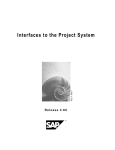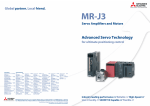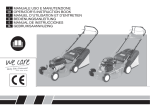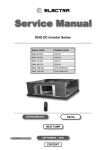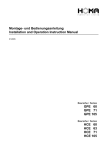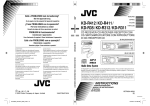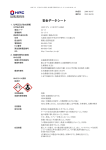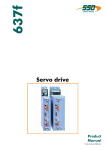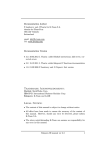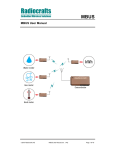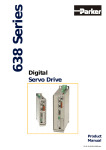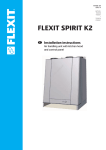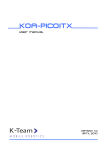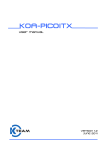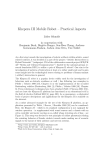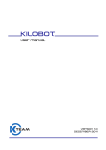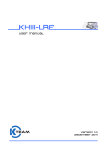Download Trademark Acknowledgments: Legal Notice: - K
Transcript
Documentation Author Frederic Lambercy for K-Team S.A. Rue Galilee 9 1400 Yverdon-les-Bains Switzerland email: [email protected] Url: www.k-team.com Trademark Acknowledgments: IBM PC: International Business Machine Corp. Macintosh: Apple Corp. SUN Sparc-Station: SUN Microsystems Corp. LabView: National Instruments Corp. MatLab: MathWorks Corp. Webots: Cyberbotics Khepera: K-Team and LAMI Legal Notice: • The content of this manual is subject to change without notice. • All effort have been made to ensure the accuracy of the content of this manual. However, should any error be detected, please inform K-Team S.A. • The above notwithstanding K-Team can assume no responsibility for any error in this manual. K-Team S.A. 1 Table Of Contents 1 Introduction 4 2 KoreMotor Hardware 2.1 Overview . . . . . . . . . . . . . . . . . . 2.1.1 Dip Switch Settings . . . . . . . . 2.1.2 Controllers I2C Addresses . . . . . 2.1.3 Motor Connection Pinout . . . . . 2.2 KoreMotor Connections . . . . . . . . . . 2.2.1 Standalone Serial Connection . . . 2.2.2 KoreBot Connections . . . . . . . 2.2.3 Koala Connections . . . . . . . . . 2.2.4 Standalone I2C Connections . . . . 2.2.5 Motors Supply Connector . . . . . 2.3 Hardware Protection . . . . . . . . . . . . 2.3.1 Electrostatic Discharge Protection 2.3.2 Motor Controller Fuses . . . . . . 3 Motor Controler 3.1 Controler State or Mode . . . . . . 3.2 Controller Status Registers . . . . 3.2.1 Target Zone . . . . . . . . . 3.2.2 SoftStop Limits . . . . . . . 3.3 Controller Option Registers . . . . 3.4 Measurements . . . . . . . . . . . . 3.4.1 Position . . . . . . . . . . . 3.4.2 Speed . . . . . . . . . . . . 3.4.3 Current . . . . . . . . . . . 3.5 Regulation Type . . . . . . . . . . 3.6 Controller Speed Profile . . . . . . 3.7 SetPoint Sources . . . . . . . . . . 3.8 Motor Blocked Test . . . . . . . . 3.8.1 Mechanical Limit Detection 3.9 Sampling Period . . . . . . . . . . . . . . . . . . . . . . . . . . . . . . . . . . . . . . . . . . . . . . . . . . . . . . . . . . . . . . . . . . . . . . . . . . . . . . . . . . . . . . . . . . . . . . . . . . . . . . . . . . . . . . . . . . . . . . . . . . . . . . . . . . . . . . . . . . . . . . . . . . . . . . . . . . . . . . . . . . . . . . . . . . . . . . . . . . . . . . . . . . . . . . . . . . . . . . . . . . . . . . . . . . . . . . . . . . . . . . . . . . . . . . . . . . . . . . . . . . . . . . . . . . . . . . . . . . . . . . . . . . . . . . . . . . . . . . . . . . . . . . . . . . . . . . . . . . . . . . . . . . . . . . . . . . . . . . . . . . . . . . . . . . . . . . . . . . . . . . . . . . . . . . . . . . . . . . . . . . . 5 5 6 7 7 8 8 8 10 10 10 11 11 11 . . . . . . . . . . . . . . . 12 12 13 14 14 14 15 15 16 16 16 17 18 19 19 20 4 Serial Communication Protocol 21 4.1 Generic User Syntax . . . . . . . . . . . . . . . . . . . . . . . 21 4.1.1 User Syntax Configuration Example . . . . . . . . . . 21 4.2 Regulation Type . . . . . . . . . . . . . . . . . . . . . . . . . 22 KoreMotor manual ver 2.0 2 A Register Summary 23 B Serial Commands Summary 26 K-Team S.A. 3 1 Introduction The KoreMotor controler board can be used as a KoreBot extension or as a standalone module that is able to control four DC motors. It provides an open loop interface or PID algorithm control with several complementary features such as current limitation, software position limits and internal commands generator. The KoreMotor can receive commands from a serial RS232 link, an I2C bus or a KNet connection from a Koala or a KoreBot. KoreMotor manual ver 2.0 4 2 KoreMotor Hardware 2.1 Overview The KoreMotor hardware provides four motor controllers, each one including a H-Bridge, microcontroler and motor connector. The fifth microcontroler manage the board communications, dispatching orders to the controllers, it is refered as the translator. Different settings and connections are required depending on the KoreMotor usage. Dip switches control the board running modes and the communication interface will set the required connections. Figures 2.1 and 2.2 describe the board main components. Motor 3 Motor 2 Serial Connector 1 8 3 2 1 Motors Supply Connector KNet Connector Motor 1 Motor 0 Figure 2.1: KoreMotor hardware overview KoreMotor manual ver 2.0 5 2.1.1 Dip Switch Settings The running mode for the KoreMotor is set with the dip swicth position at startup. The settings are described on figure 2.2. If the switch position is modified at run time, the mode will not change until the next reset. I2C Standalone : That mode is used to control the board from an I2C bus. The I2C bus is directly connected to the motor controllers, and the I2C addresses for each controller are detailled in section 2.1.2. The translator is not used in this mode. The KoreMotor can be connecter to any I2C master as a standalone I2C device, for instance a KoreBot can be configured as an I2C master for the KoreMotor. Koala KNet : The Koala KNet mode is the classical KNet protocol implemented on the Koala robot and the Khepera robot. This mode is mainly designed to connect a KoreMotor as a Koala extension, refer to the Koala user manual for details about the KNet protocol. RS232 User Interface (115200): User serial commands (see section 4.1) can be send to the KoreMotor serial interface with this mode. The serial line settings should be 115200 bps, no parity, 8 data bits and 2 stop bits. Dip switch settings Reset switch 0: I2C standalone mode 1: standard SPI mode 2: KNet mode 3: RS232 115200bps mode Figure 2.2: Dip switch settings K-Team S.A. 6 2.1.2 Controllers I2C Addresses I2C Adress range 1 I2C Adress range 2 Figure 2.3: KoreMotor I2C address range The last dip switch, as displayed on figure 2.3 is used to choose the I2C address range for the motor controllers. The address range is usefull to stack two KoreMotor together, using the same I2C bus. Motor Motor Motor Motor 2.1.3 0 1 2 3 address address address address Range 1 0x01 0x02 0x03 0x04 Range 2 0x05 0x06 0x07 0x08 Motor Connection Pinout 7 5 3 1 10 8 6 4 2 9 1. Motor + 2. Encoder 5V 3. Encoder Canal A 4. Encoder Canal B 5. Encoder Gnd 6. Motor − 7. Motor + 8. Motor − 9. Encoder Index 10. Encoder Index Figure 2.4: KoreMotor connector pinout The KoreMotor provides four DC motor connectors. The motor connection may vary from a manufacturer to another, but the signals for quatrature encoders are usually similar. Please refer to your motors manufacturer datasheet for details about the motor connections, contact [email protected] if further help is necessary. Motor+ : First motor connection Motor- : Second motor connection Encoder 5V : Power supply for the encoder Encoder Gnd : Ground reference for the encoder Encoder A : First encoder phase K-Team S.A. 7 Encoder B : Second encoder phase Encoder Index : Index for the encoder. This signal is not available for all encoders and it is not required. 2.2 KoreMotor Connections The KoreMotor requires a power supply connection and an external interface connection. The main power supply is the motors supply, it should be set according to the motors requirements, regarding voltage and necessary current, and is common for all motors. Another supply may be necessary for the electonics on the board. This supply is provided from the KoreBot or the Koala when the KoreMotor is used as an extension, but it is required for standalone use. The external interface depends on the chosen dip switch settings. The possibilities are: - KoreBot connection for I2C or KNet 2.0 interface - Koala connection for KNet interface - Standalone serial connection for both RS232 interface - Custom connection for a standalone I2C interface 2.2.1 Standalone Serial Connection The standalone serial connection is used for both serial protocol mode. A KoreConnect option, which provides the RS232 transceiver, is necessary to use the KoreMotor in standalone serial mode. A custom made RS232 transceiver can be used as well, schematics are available on request at [email protected]. The serial cable can then be connected to any PC. A 5V supply voltage is required for the board electronic components (see section 2.2.1). How to Supply 5V for Electronics When using the board as a standalone module, a 5V external supply is necessary. That supply should be provided using the red KNet connector (see section 2.1) as displayed on figure 2.6. 2.2.2 KoreBot Connections The KoreBot connection is pretty straightforward, the boards should be simply stacked together. The KoreBot will provide the electonics 5V supply, and only the motors supply should be added. Dip switch setting should be standalone I2C to use the I2C bus for communications between the KoreBot and the KoreMotor. K-Team S.A. 8 RS232 cables KoreConnect Figure 2.5: Standalone serial connection 1 GND 5V 8 Figure 2.6: Standalone 5V electronics supply K-Team S.A. 9 2.2.3 Koala Connections The Koala must be connected to the KoreMotor using the red KNet connector (see section 2.1). A cable should be provided with the KoreMotor to be connected with the Koala K-Bus connector (please refer to the Koala user manual for more details). The electronics supply is provided from the Koala, the motors supply can be connected to an external source or to the Koala 12V outputs. Dip switches should be set to the Classical KNet mode, the Koala does not support the KNet 2.0 protocol. 2.2.4 Standalone I2C Connections 1. I2C SDA 4. Serial Tx 2. I2C SCL 11. Gnd 3. Serial Rx 12. Gnd 9 7 5 3 1 12 10 8 6 4 2 11 Figure 2.7: KoreMotor serial connector and I2C connections The KoreMotor can be connected to an external I2C bus, and controlled as a set of standard I2C devices (see section 2.1.1 for details). Three signals (SDA, SCL and GND) are necessary to connect the I2C bus, they are displayed on figure 2.7 with the relevant connections on the serial connector. The electronics supply must be provided separately, and the dip switches should be set to standalone I2C mode. 2.2.5 Motors Supply Connector The main power connector will supply all the motors, the voltage should match the motor requirements, and stay within the accepted voltage range for the H-Bridges. The connector pinout is detailed on figure 2.8. Voltage range Max global current Max current per motor K-Team S.A. 5-28V 5A 2A 10 Ground 5−28V 1 8 3 2 1 Figure 2.8: Motors power connection 2.3 2.3.1 Hardware Protection Electrostatic Discharge Protection As any electronic device, the KoreMotor can be damaged by Electrostatic Discharge. The quadature encoders interface chip on the board has been identified as very sensitive and special care should be taken to avoid any problem. It is recommended to connect the KoreMotor ground signal to the earth or with the robot chassis for embedded use. A quadrature encoder interface failure will shut the board ability to read encoder feedback and globaly prevent the related motor controller proper operation. 2.3.2 Motor Controller Fuses The motor cotrollers are protected from overcurrent with dedicated fuses. Each motor channel is protected with a 2 Amps fuse, and the board is protected with a general 5 Amps fuse. Higher peak currents are normaly supported by the board and all its components, but continuous operations should respect these limits. Please contact your K-Team dealer for support if a fuse replacement is required. K-Team S.A. 11 3 Motor Controler 3.1 Controler State or Mode Each motor controller status is indicated, or can be modified, using the mode register (0x28). This register should be read to check the controller state, and it can be written to switch from a mode to another. The following modes are available: Idle mode: This is the default startup state (except if hardware option 0 is set). While in idle mode the controller will not execute any regulation and the motor is free wheeling. Control mode: The controller must be switched to this mode for any regulation to start. When exiting Control Mode, the regulation will stop according to the new mode description. Stop mode: When switched to this mode, the controller will hold the motor in blocked state (both motor pins are electricaly connected). Sleep mode: The controller is switched to a minimal activity status and the motors are set to free wheeling. This mode can be used to optimize power consumption. Reset mode: Mode to reset the controller. The controller will then switch to the startup mode, according to hardware option 0. Save configuration mode: Save all registers to EEPROM for backup. A special protection patern must be written in register 0x28 to access this mode. Values 0x55, 0xAA and 0x05 must be written sequentially to enter mode 5. The first two values are not stored to the register and cannot be read. The controller will switch back to idle mode when the backup is completed. Search limit mode: This mode will start a mechanical limit detection routine. The routine will use speed regulation to perform the test, using the current target point setting and motor blocked test (see section 3.8). Resulting 32bit positions are stored in SoftStopMin (0x4A0x4D) and SoftStopMax (0x4E-0x51). The controller will switch back to idle mode when the test is completed. KoreMotor manual ver 2.0 12 3.2 Controller Status Registers Two registers detail the motor controller status. Bit will be set by the controller in the Error register (0x2D) to signal problems. Generic information about the controller are given in the Status register (0x2E). Some errors, from error 0 to 4, are blocking errors, that means the controller will stop until the error are not cleared. The error will be cleared only if the error condition has been resolved and after the Error register is cleared from the application, that means writing 0x0 to the error register. If a blocking error is triggered because of a physical condition, such as a blocked motor, the condition itself should be resolved before clearing the error register. bit0 : bit1 : bit2 : bit3 : bit4 : bit5 : bit6 : bit7 : bit0 : bit1 : bit2 : bit3 : bit4 : bit5 : bit6 : bit7 : Error register Sample time too small The defined sample time is too small for a complete calculation cycle. Watchdog timer overflow Refer to the PIC16F876 datasheet Brown-out Refer to the PIC16F876 datasheet Software stoped motor The motor position is off-limits and the sw stop error option is enabled. Motor blocked The motor blocked condition is met (see section 3.8) and the sw blocked stop option is enabled. Position out of range Not implemented Speed out of range Not implemented Torque out of range Not implemented Status register Movement detected Motor speed is not null Direction Movement direction 0=negative 1=positive On setpoint The regulated value match the SetPoint value Near setpoint The regulated value is inside the target zone Command saturated The PWM ratio has reached 100% Antireset windup active Set if the command is saturated and if sw windup is enabled Current control active Softstop active The position is off-limits and the corresponding option is enabled (section 3.2.2) K-Team S.A. 13 3.2.1 Target Zone The near setpoint flag is set whenever the regulated value is such as: |SetP oint − RegulatedV alue| ≤ N earT argetM argin That means the NearTargetMargin register defines a zone around the target point. which can be useful for specific applications. 3.2.2 SoftStop Limits The Controller can be configured to setup virtual position limits for movements. This feature is very useful to protect mechanical devices powered by the KoreMotor. As soon as the position is under SoftStopMin (0x4A-0x4D) or over SoftStopMax (0x4E-0x51), the controller will shutdown the motor driver to prevent any further movement regardless of the target setpoint and controller mode. The SoftStopMax limit is only active if the sw stopmax option is enabled and the SoftStopMin limit is only active if the sw stopmin option is enabled. Any combination of these two options is valid, and they should be set according to each specific application requirements. 3.3 Controller Option Registers The controller behaviour can be configured using the two option registers (0x2A and 0x2B) where each bit will enable or disable a feature. The registers can be read at any time to retrieve the current option settings and options are activated or disabled as soon as a register is written. K-Team S.A. 14 Software option register sw separated Use alternate algorithm PID derivation. The derivate part is calculated using the process variable rather than the error. Activate the anti reset windup routine. sw windup sw stopmin Stop the motor if the min position is reached (section 3.2.2). Stop the motor if the max position is sw stopmax reached (section 3.2.2). sw stop error Generate an error when position is out of limits, in this case the error must be reseted before any further commands can be executed. sw blocked stop Stop the motor if the blocked condition is met (section 3.8). sw current ctrl Activate software current limitation (Not implemented) Invert the motor direction. sw dir inv bit0 : bit1 : bit2 : bit3 : bit4 : bit5 : bit6 : bit7 : bit0 : hw bit1 : hw bit2 : bit3 : hw hw bit4 bit5 bit6 bit7 hw hw hw hw 3.4 : : : : Hardware option register startup Startup mode (0 = idle mode, 1 = control mode) analog set Use analog input for setpoint (Not Implemented) led Not Implemented resolution Resolution for the encoder (0 = 100%, 1 = 25%) torque inv Invert the internal current measurement opt1 Not Implemented opt2 Not Implemented opt3 Not Implemented Measurements Each controller can return the motor incremental position, the motor current speed, and the current through the motor. Each measurement can be retrieved reading the corresponding registers, the most significant bits for each value should always be read first to ensure data consistency. 3.4.1 Position The returned motor position is an accumulated counter of encoder pulses. The physical position can be calculated knowing a reference position and the K-Team S.A. 15 pulse per turn value for the encoder. The position registers can be writen to set the current position to a given value at any time. 3.4.2 Speed The speed value is a division of a constant value by the time between encoder pulsations. In default mode (pulsation x2 and postcaler 1:4), a measure is made every two pulsations. The constant value is define by the maximum time multiplied by 256 (0xFFFF * 256 = 16’776’960). This operation allows a better pid calculation for the lower speed. 16′ 776′ 960 T imer5value To convert into a real time, use the following calculation: M otorSpeed = T ime = T imer5value fosc /4 T mr5P rescaler Where fosc = 20MHz and Tmr5Prescaler = 8 (default). 3.4.3 Current The measured current (Torque registers) is proportional with the maximum supported current. The default maximum current is 2 Amps, and it is represented by a +512 measured current. A −512 value represents the reverse maximum current (thus 2 Amps by default), any intermediate value can be deduced from the proportional relation. The maximum supported current can be reduced to increase the current measurement resolution, please contact K-Team for further information. The current measurement can be disturbed because of the analog amplifier bias. That means a null value for the measured current does not match the motor standby current. The Torque bias register (0x3C) is used to correct this variation, the default bias is measured at startup, when it is assumed the motor is not moving. The returned current value is corrected using the bias such as: RetunedV alue = M easuredV alue − Bias The default bias can be modified if the startup value is incorrect. 3.5 Regulation Type The controler supports six different type of regulation. Each regulation will use a specific set of PID coefficient, depending on the parameter which is actually regulated. The PID coefficients are usual proportional, derivate K-Team S.A. 16 and integral gains for the controller, several other settings may be required for each specific mode and application. The 32 bit SetPoint value (0x2F-0x32) is always used as the controller input. According to the regulation type, this register will set the target position, speed, or current. The actual controller internal input is only updated when the least significant byte is written (0x2F) to ensure consistency. Open Loop control: The open loop mode does not use the PID controller. The SetPoint value will directly set the output PWM ratio. The PWM timer for the controller is a 10 bit timer, that means the PWM ratio can vary from +1024 to −1024 with the sign indicating the direction. A null value generates no signal, while a 1024 value generate a 100% PWM ratio (continuous signal). Position control: The motor position is regulated to the SetPoint value. The position coefficients are required for the PID controller. Position control with speed profile: A speed profile is used to reach the target position defined in the SetPoint registers. The speed regulation is actually used to follow the speed profile that is why speed coefficients are required for the PID controller. The position PID is not used in this mode. The speed profile is defined by the MaxSpeed register (0x6D) and Acceleration register (0x52), see section 3.6 for further details. The final position is held using the blocked motor mode in the target zone, which is defined using NearTargetMargin (0x60). Speed control: The motor speed is regulated to the Setpoint value. As speed is a 16 bit measurement, no speed beyond ±215 can be regulated. The speed coefficients are required for the PID controller. Speed control with acceleration profile: The motor speed is regulated to the SetPoint value, but an acceleration ramp is used to reach the final speed. According to the Acceleration register (0x52) and current speed, the speed is gradually increased or deacreased until on SetPoint. Current Control: The motor current is regulated to the SetPoint value. As current is a 10 bit measurement, no current beyond ±29 can be regulated. The current coefficients are required for the PID controller. 3.6 Controller Speed Profile When using position control with speed profile mode, the controller aim for a target position using a speed control PID. That means the position itself is not regulated, even thought the given SetPoint is a position. On the other hand, the motor speed is regulated according to the built-in speed K-Team S.A. 17 profile. Figure 3.1 describe the speed profile, as it can be configured using the MaxSpeed and Acceleration registers. MaxSpeed −Acceleration Acceleration Start Position Target Position Figure 3.1: Speed Profile 3.7 SetPoint Sources The target point (see section 3.5) for the controller can be set from various sources. The most common use is to set the target point by writting into the SetPoint registers (0x2F-0x32) but other sources may be useful for specific applications. The source can be modified using the SetPoint Source register (0x29). The default mode 0 requires writting to the SetPoint register, other modes will use internal generators as described bellow. Square Generator: As displayed on figure 3.2, the mode 2 will generate a square wave signal for the SetPoint according to the IntGenPeriod, IntGenAmplitude and IntGenOffset registers. IntGenOffset is a signed value. IntGenPeriod (IntGenAmplitude/2) + IntGenOffset 0 −(IntGenAmplitude/2) + IntGenOffset IntGenOffset Figure 3.2: Square waveform K-Team S.A. 18 Triangle Generator: As displayed on figure 3.3, the mode 3 will generate a triangle signal for the SetPoint according to the IntGenPeriod, IntGenAmplitude and IntGenOffset registers. IntGenOffset is a signed value. (IntGenAmplitude/2) + IntGenOffset 0 IntGenPeriod IntGenOffset −(IntGenAmplitude/2) + IntGenOffset Figure 3.3: Triangle waveform 3.8 Motor Blocked Test The controller uses a built-in routine, based on movement and current measurement, to detect if the motor abnormaly blocked. A blocked condition is met only if the motor is not moving and if the measured current is over the defined SWCurrentLimit (0x56-0x57). The motor blocked flag and eventual error are only triggered if the both conditions are met during at least a BlockedTime (0x46) period. That means the blocked flag will never be set if the motor is moving, even very slowly, and it will never be set if the current limit is not defined properly, according to the controlled system. The blocked time period can be calculated from the sampling period such as: BlockedP eriod = 2 ∗ SamplingP eriod ∗ BlockedT ime 3.8.1 Mechanical Limit Detection Controller mode 6 can be configured to use the built-in mechanical limit detection routine. The mechanical limit detection is based on the motor blocked test, that should be configured properly before switching to this mode. The routine will use the current SetPoint value as the target speed to perform the test, that is why the SetPoint register should be adjusted as well. K-Team S.A. 19 Once all relevant registers are set, switching to mode 6 will start the detection routine. The routine will search for mechanical limits in both directions. If no limit is reached in one direction or another, the test will fail and the routine will run continuously, driving the motor at the given SetPoint speed, until the controller mode is manually changed. Resulting 32bits positions for mechanical limits are stored in SoftStopMin (0x4A-0x4D) and SoftStopMax (0x4E-0x51). The controller will switch back to idle mode when the test is completed. 3.9 Sampling Period The controller sampling period is the time between two output calculations. That means the PWM ratio to control the motor is only updated once every sampling period. A shorter sampling period may result in a more accurate control but requires a better encoder resolution. If the encoder resolution is too bad, the controller might not count any pulse during a sampling period thus assuming no movement, even if the motor is rotating. Moreover, if the sampling period is too small, error 0 may occur, indicating that the microcontoller is too slow to complete all the PID calculations in a single period. On the other hand, if the sampling period is too long, the controller might not be quick enough to regulate the system, as its reaction time might become too long. Setting a correct sampling period is critical to ensure proper motor control. The Sampling period should be set using the SampleTimeH register (0x45). The internal timer provide a 1.6µs resolution for the sampling time so that the sampling period can be calculated as: SamplingP eriod = (SampleT imeH ∗ 256) ∗ 1.6µs The SampleTimeL register (0x44) can be used for finer tuning of the Sampling period, down to a 1.6µs resolution, but period under 1300µs are very unlikely to be acceptable. K-Team S.A. 20 4 Serial Communication Protocol 4.1 Generic User Syntax The KoreMotor supports various high level serial commands to control the board from a host Personnal Computer. The serial command syntax is similar to the Khepera syntax with some enhancements. Each command is a letter eventually followed by numerical arguments. Arguments format is either 8bit (default), 8bit hexadecimal, or 32bit integer. The format for each argument is given in the command description (ie value.format), but is 8bit by default. A prefix must be added to an argument with a specific format as described in the following table: 32bit integer l 16bit integer d 8bit hexadecimal 0x Some user command syntax examples: Set options: O,0,0x24,0x02 Set target point: Set Position: Configure PID: 4.1.1 P,0,1,l-100 A,1,l20 C,2,1,d300,d0,d120 User Syntax Configuration Example Configuration of a motor controller (number mot) from the serial line. W,mot,0x28,0 W,mot,0x33,0 W,mot,0x45,6 W,mot,0x60,10 W,mot,0x2D,0 W,mot,0x46,10 L,mot,5,l50,l0 L,mot,1,l-10000,l10000 O,mot,0,62 C,mot,3,d1500,d0,d300 C,mot,1,d70,d50,d10 J,mot,d10,1 S,mot KoreMotor manual ver 2.0 - Set mode Set filter order Set sample time Set error margin Reset all error flags Set default blocked time Set current limit Set position limit Set options Configure speed PID Configure position PID Set speed profile Save Config 21 N,mot,2,l3 R,mot,0x4A R,mot,0x4B R,mot,0x4C R,mot,0x4D R,mot,0x4E R,mot,0x4F R,mot,0x50 R,mot,0x51 4.2 - Search for limits - Read min position byte - Read min position byte - Read min position byte - Read min position byte - Read max position byte - Read max position byte - Read max position byte - Read max position byte 0 1 2 3 0 1 2 3 Regulation Type The motor controller supports five different type of regulation (see section 3.5), serial commands set the affected regulation using a number, according to the following table. A command requiring a regulation type must use one of these reference number. 0: Open loop control 1: Position PID control 2: Position control with a trapezoidal speed profile 3: Speed PID control 4: Speed with trapezoidal accelaration profile K-Team S.A. 22 A Register Summary Name Mode Address 0x28 SetPointSource 0x29 HW Options 0x2A SW Options 0x2B Description Selection of mode (0..7) 0 = Idle Mode 1 = Normal Control Mode 2 = Stop Motor 3 = Sleep Mode 4 = Reset Mode 5 = Save configuration parameters (page 0) in E2PROM 6 = Search Limit Mode 7 = Unused Source of SetPoint (0..7) 0 = External I2C 1 = External Analogic (not implemented) 2 = Internal Square Wave Generator 3 = Internal Triangle Generator 4 = Internal Sinus Generator (not implemented) 5 = Not used 6 = Not used 7 = Not used Hardware options (Flags) Bit0: Define Startup Mode, 0=Idle Mode / 1=Normal Control Mode Bit1: Analog SetPoint Input, 0=disabled / 1=enabled Bit2: LED, 0=disabled / 1=enabled Bit3: Encoder resolution, 0=100% / 1=25% Bit4: Torque Inversion Bit5: Driver Option 1 Bit6: Driver Option 2 Bit7: Driver Option 3 Software options (Flags) Bit0: Seperate D, 0=disabled / 1=enabled Bit1: Antireset Windup, 0=disabled / 1=enabled Bit2: SoftStop MIN, 0=disabled / 1=enabled Bit3: SoftStop MAX, 0=disabled / 1=enabled Bit4: Error on SoftStop, 0=disabled / 1=enabled Bit5: Stop Motor when blocked, 0=disabled / 1=enabled Bit6: Current Control by Software, 0=disabled / 1=enabled Bit7: Direction invertion, 0=disabled / 1=enabled KoreMotor manual ver 2.0 23 ControlTyp 0x2C ErrorFlags 0x2D StatusFlags 0x2E SetPointLL SetPointLH SetPointHL SetPointHH PositionLL PositionLH PositionHL PositionHH SpeedLL SpeedLH SpeedHL SpeedHH TorqueL TorqueH TorqueBiasL TorqueBiasH 0x2F 0x30 0x31 0x32 0x34 0x35 0x36 0x37 0x38 0x39 0x3A 0x3B 0x5A 0x5B 0x3C 0x3D K-Team S.A. Type of PID Control (0..7) 0 = Open Loop 1 = Position control with no speed Profile 2 = Position control with Trapezoal Speed Profile 3 = Speed control with no speed profile 4 = Speed control with Trapezoal acceleration Profile 5 = Torque control 6 = Zero Friction control (not implemented) 7 = Not implemented Flags indicating an error (read only!) Bit0: Sample time to small Bit1: Watchdog timer overflow Bit2: Brown-out Bit3: SoftStop happened (only if SoftStop enabled) Bit4: Motor blocked (only if Motor stop while blocked enabled) Bit5: Position out of range (Overflow), 0=No / 1=Yes Bit6: Speed out of range (Overflow), 0=No / 1=Yes Bit7: Torque out of range (Overflow), 0=No / 1=Yes Flags indicating the status of the controller (read only!) Bit0: Movement detected, 0=No / 1=Yes Bit1: Direction of movement, 0=negative / 1=positive Bit2: On SetPoint, 0=No / 1=Yes Bit3: Near SetPoint (+/-5units), 0=No / 1=Yes Bit4: Saturation of Driver Command, 0=No / 1=Yes Bit5: Antireset Windup active / Integrator Owerflow, 0=No / 1=Yes Bit6: Current Control active, 0=No / 1=Yes Bit7: SoftStop active, 0=No / 1=Yes 32bit target point Target point is only updated when the LL value is writen Always first read the PositionHH register!!! These 4 variables contain a copy of the 32bit position Always first read the SpeedHH register!!! These 4 variables contain a copy of the 32bit Speed Always first read the TorqueHH register!!! These 2 variables contain a copy of the 16bit Torque These 2 variables contain the 16bit Bias of the Torque Measurement 24 KpSpeedL KpSpeedH KdSpeedL KdSpeedH KiSpeedL KiSpeedH SampleTimeL SampleTimeH BlockedTime 0x3E 0x3F 0x40 0x41 0x42 0x43 0x44 0x45 0x46 IntGenPeriod 0x47 IntGenAmplitude IntGenOffset SoftStopMin SoftStopMax Acceleration StaticFriction SWCurrentLimitL SWCurrentLimitH MinSampleTimeL MinSampleTimeH TorqueL TorqueH MinSpeedL MinSpeedH NearTargetMargin KpPos KdPos KiPos KpTorque KdTorque KiTorque MaxSpeed 0x48 0x49 0x4A 0x4E 0x52 0x54 0x56 0x57 0x58 0x59 0x5A 0x5B 0x5E 0x5F 0x60 0x61 0x63 0x65 0x67 0x69 0x6B 0x6D Kp for speed PID Kd for speed PID Ki for speed PID Sampling time [h=SamplingTime*1.6us] (20MHz) Time to wait before the motor is considered blocked [T=BlockedTime*256*h] Period of internal function generator [T=IntGenPeriod*256*h] (0..255) Amplitude of internal function generator (0..255) Offset of internal function generator (-127..127) 32bit Position of SoftStop minimum 32bit Position of SoftStop maximum Acceleration for trapezoidal speed profile (0..255) Friction of the system (0..255) Software current limit (16 bit) used for blocked detection and software current limit Time used to pass one cycle Always first read the TorqueHH register!!! These 2 variables contain a copy of the 16bit Torque Minimal consigne Speed for regulation control with trapezoidal or constant speed Margin for near target flag setting and speed profile Kp for Position PID Kd for Position PID Ki for Position PID Kp for Current PID Kd for Current PID Ki for Current PID Maximum speed for trapezoidal speed profile K-Team S.A. 25 B Serial Commands Summary A Set Position Command: Answer: Effect: B Read Software Version Command: Answer: Effect: C A, mot, position.32 a Set the position counter for the given controller. B b, TranslatorVersion, ControllerVersion Give the software version for the translator firmware and the motor controller firmware. Configure PID controller Command: Answer: Effect: C, mot, RegulationType, Kp.16, Kd.16, Ki.16 c Configure the PID controller for the given regulation, set the proportional (Kp), integral (Ki), and derivative (Kd) gain. These parameters must be set separately for each regulation type. D Unused E Get controller status Command: Answer: Effect: E, mot e, 0xStatusFlags, 0xErrorFlags Return the status and error flags for the given controller. Refer to section 3.2 for flags definition. Both returned values are 8bit integer. F Unused G Unused KoreMotor manual ver 2.0 26 H Set Source for the Regulation Target Point Command: Answer: Effect: H, mot, RegulationType, Source, Period, Amplitude, Offset h Set a new target point source for the given controller. The default source is to use external commands from the translator. This command will start regulation according to the new source, other relevant parameters should be set fisrt. I Unused J Set Speed Profile Command: Answer: Effect: J, mot, MaxSpeed.16, Acceleration j Set the speed profile for regulation type 2, which is position control using a trapezoidal speed profile. K Unused L Set System Limits Command: Answer: Effect: M L, mot, RegulationType, ValueMin.32, ValueMax.32 l Set software limits for position, speed or current. The affected limit is determined from the given regulation type. 1 or 2 affect position, 3 or 4 affect speed, and 5 affects current. Warning: to set the current limit, only the 16 least significant bits of the ValueMin are used. These 16 bits are interpreted as an unsigned integer. Get Measurement Command: Answer: Effect: K-Team S.A. M, mot, RegulationType m, Measure Get speed, position or current measurement from the given motor. The returned value is a 32bit integer and the measurement is determined from the given regulation type. 1 or 2 give position, 3 or 4 give speed, and 5 give current. 27 N Search System Mechanical Limits Command: Answer: Effect: O Set Controller Options Command: Answer: Effect: P N, mot, BlockedTime, Speed.32 n, Use the given speed, to initiate limits detection cycle. The limit detection is based on the current limit set with L, and the given time. Refer to section 3.8 for a detailled description of the detection cycle. O, mot, HardwareOption, SofwareOption o Set options for the given controller, refer to section 3.3 for a detailled description of available options. Set New Target Point Command: Answer: Effect: P, mot, RegulationType, TargetPoint.32 p Start the regulation to the new target point. The regulation type determine if the setpoint is a speed, position or current target. All other parameters relevant for regulation should be set first. Q Unused R Read I2C Register Command: Answer: Effect: S R, mot, Address r, 0xData Read a register from the given controller. The returned value is the 8bit content of the register, and the Address should be a valid 8 bit address either decimal or hexadecimal. Refer to section A for register descriptions. Save Controller Configuration Command: Answer: Effect: K-Team S.A. S, mot s Store all registers value to EEPROM for the given controller. These saved values are not erased when the card is switched off and are automatically restored at startup. 28 T Unused U Unused V Unused W Write to I2C Register Command: Answer: Effect: W, mot, Address, Data w Write a value to the given register. The address should be a valid 8bit decimal or hexadecimal address and the value a 8 bit integer. X Unused Y Unused Z Unused K-Team S.A. 29





























